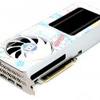Product Photos
Product Photos
The Ampere series will replace the Turing lineup, which will fade out of the market as these cards sit right on top of their prices yet are much faster.
- The reference 3060 cards have a peak boost clock up-to 1.78 GHz, with the base clock hovering in the 1.32GHz domain.
- The reference 3060 Ti cards have a peak boost clock up-to 1.66 GHz, with the base clock hovering in the 1.41 GHz domain.
- The reference 3070 cards have a peak boost clock up-to 1.73 GHz, with the base clock hovering in the 1.50 GHz domain.
- The reference 3080 cards have a peak boost clock up-to 1.71 GHz, with the base clock hovering in the 1.44 GHz domain.
- The reference 3090 cards have a peak boost clock up-to 1.70 GHz, with the base clock hovering in the 1.40 GHz domain.
When you hit the button, the card clocks in at a boost frequency of 1822 MHz, and yes, it has two different BIOS modes. Acoustics wise it's the same, so we have no idea why you would enable reference mode over the OC one. However, it is usually a good idea to have a failsafe BIOS.
By the way, these are out-of-the-box programmed clock frequencies; no further software is required. As mentioned, it weighs roughly 1 kg and is 2 slots wide, its length 29cm. Our factory-tweaked variant comes with a backplate as standard equipment. There is just a hint of RGB LEDs implemented, which actually is preferred by many. Colorful, as the name implies, features a bright and cheerful design :)







